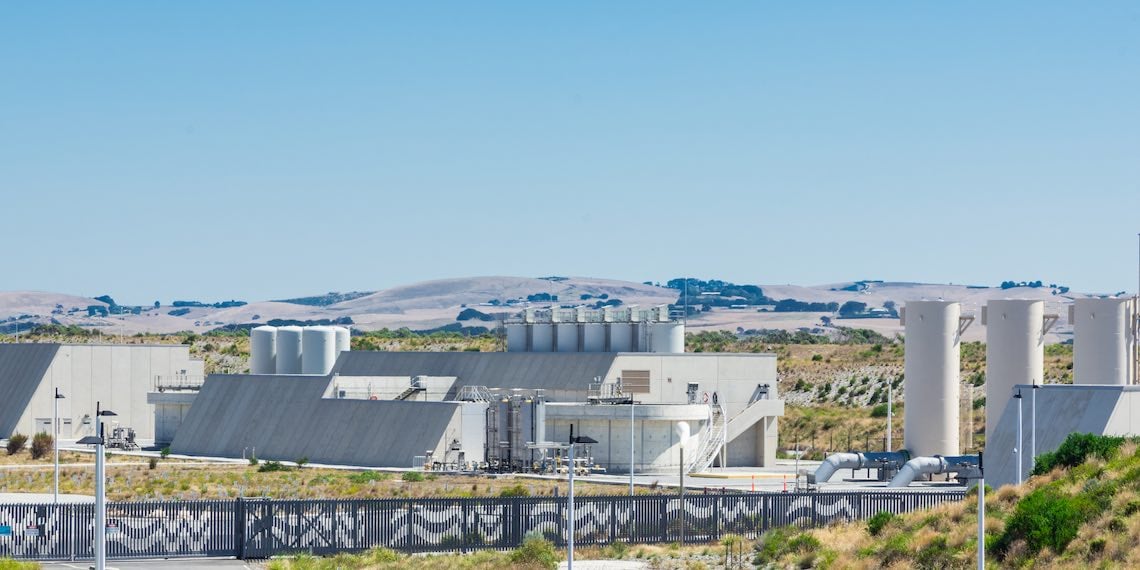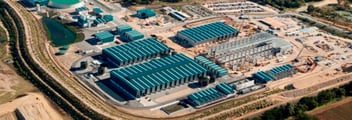Decarbonising desalination a key opportunity for water security

As the water sector works towards net zero, ensuring decarbonisation in all areas of water treatment will be important, but one leading water expert says focusing on reducing carbon emissions from desalination will offer huge benefits for water security.
Stantec Australia Practice Leader in Desalination, Mahesh Dhargalkar, said the potential for desalination to ensure a reliable source of water into the future is huge, with the option set to sore as renewable energy sources become more readily available.
“Desalination is a reliable water resource. Seawater is in abundance and it’s not weather dependent. Most of our other options available rely on surface water,” he said.
“The main water source currently used is river and dam capture, which has its own socio-economic impacts. We spend a big amount of money on surface water infrastructure, but still have uncertainty because we don’t always get rain into the catchments.
“There are financial considerations, but we need to pay for all the projects we do. When you see the reliability and sustainability of desalination, it scores highly when compared to other infrastructure investments that we do, especially when it comes to water security.”
While reliable, desalination still has a way to go in terms of decarbonisation, Dhargalkar said, but a lot of work is currently underway to create more energy-efficient desalination processes and to consider how to supplement the energy requirements with renewables.
“The carbon footprint for desalination depends on several primary factors. These include the source of energy, which is one of the largest portions to be considered. The type of desalination technology used is also a factor, too,” he said.
“But it can also depend on the salinity of the water. The salinity level between brackish and seawater changes dramatically, and this is why seawater is more energy intensive to treat. The location of the plant can also contribute to the carbon footprint as well.
“Most states around Australia currently use desalination as critical backup. Some of these plants are continuously running.
“But with advances being made in the industry, desalination is moving from being a stop-gap arrangement towards a more permanent, reliable option and will likely become a major source in coming years.”
State of play
Studies have shown that greenhouse gas emissions are higher with seawater desalination from Electrodialysis (ED), Dhargalkar said, which can be in the range of 2.46 kilograms CO2eq per m3.
“Reverse osmosis (RO) has been found to have lower CO2 emissions compared to thermal desalination, due to the energy requirements. The estimated footprint we have seen for seawater RO can be in the range of 0.4-6.7 kilograms CO2eq per m3.
“Having said that, the carbon footprint for seawater RO is predominantly based on the energy source. Around 45-60% of operating costs comes from the energy consumption, mainly due to the high-pressure pump that’s required.”
Dhargalkar said the energy used for the desalination process has a big impact on the carbon footprint, but there is innovative work being done to increase the uptake of renewables.
“Obviously, energy is one of the largest contributors to the carbon footprint. Alternative energy resources are probably the immediate solution to address the problem,” he said.
“There is a solar-powered desalination plant in Saudi Arabia producing around 60,000 cubic meter per day and has a claimed carbon footprint of around 0.2 kilograms CO2eq per m3. There is a drastic reduction in CO2 because of the compensation of energy sources.
“In Perth, wind power supplements the desalination plant, it is somewhere around 0.3 kilograms CO2eq/m3. So, we know compensating hydrocarbons for renewable energy sources is a major solution.
“A renewable energy back up desalination plant would be greatly advantageous, which is something Australia is working towards. We are on that path.”
Dhargalkar said the use of renewables in the desalination process has been trending up and will continue to do so as more renewable energy is generated.
“Around 2010, renewable energy use in the desal sector was at about 1%. In 2020, it was 10%. In 10 years, we are expecting a jump again. The market around the cost of renewables is going to change considerably. We are going to have more options available,” he said.
Technology train
Focusing on powering the desalination process with renewables is a big factor, but Dhargalkar said there is also a lot of efficiencies being gained through the development of innovative desalination technologies, as well.
“Innovations are helping in terms of reducing the amount of energy needed for production. At the moment, it’s about 3.5KW per m3 for desalination. And the membranes are being looked at to add an extra layer of innovation,” he said.
“Our RO membranes are becoming more energy efficient and there will be more benefits coming out of that research. Some work being done in the US is creating membranes that reduce the energy consumption by 50%, just through innovation in the membrane technology.
“There are also opportunities to improve the energy efficiency of existing desalination plants. There is room there for some work to help transition older plants into new and more energy efficient ways of operating.”
Dhargalkar said that there is certainly a need to both reduce energy consumption and switch to more renewable energy use, but there are also other avenues to explore when it comes to managing desalination production more cost-effectively.
“With the rate of innovation, we can aim to use less energy per litre to produce more desalinated water from the same infrastructure,” he said.
“For example, if the same energy consumption required for a 100ML/d desalination plant could, in the future, produce 120ML/d, then why not?
“When looked at this way, why wouldn’t we reduce the stress being placed on surface water sources if the costs are the same?”
Public acceptance
Although there are still some challenges to overcome when it comes to decarbonising, Dhargalkar said a key part of ensuring a successful transition to more predominant use of desalination will be educating and consulting with the community.
“It’s not a new technology. Desalination has been around for decades. There are countries that are fully dependent on this alternate and reliable source of water. But here we are regularly facing drought conditions and we are still debating it,” he said.
“As water industry professionals, we trust our technology. We know what we are doing. But it’s about bringing the community along with us. Engineers can talk to engineers about water technology improvements and all agree. The challenge comes with helping build awareness outside of the industry.
“We need to increase the water literacy of the general public around desalination and recycled water, and why it’s so important to start shifting towards alternative water options.
“We are trying to be more transparent. We want people to understand that these options are safe, and hugely beneficial. Seawater goes in and drinking water comes out. It’s actually pretty amazing what we can do.”


